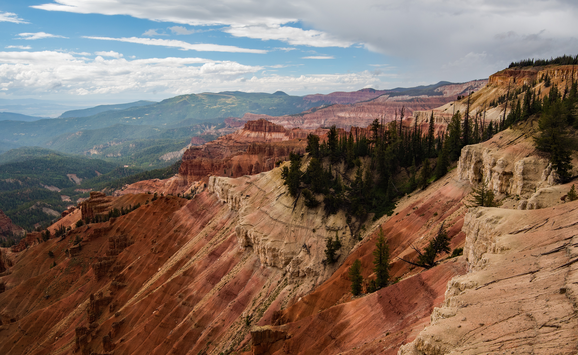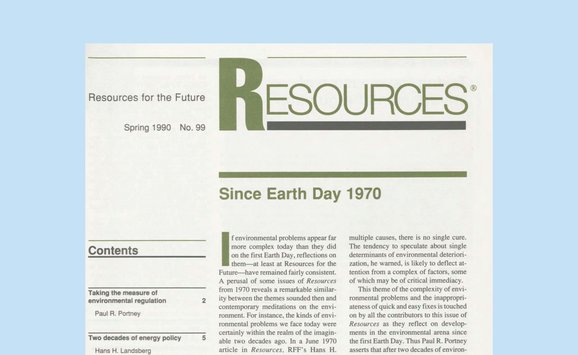In this week’s episode, host Margaret Walls talks with Megan Lawson, an economist and researcher at Headwaters Economics, about how outdoor recreation economies support communities throughout the United States despite creating unique challenges for their residents. Many US communities that border public lands and scenic natural areas have recreation-dependent economies, meaning a majority of the local economy is driven by recreational activities and tourism. Lawson explains how recreation-dependent economies can be vulnerable to over-tourism, shortages in affordable housing, and increased risk of wildfires and floods. Lawson then unpacks the feasibility of public land sales to address challenges in making affordable housing available and describes ways to increase hazard resilience in recreation-dependent communities to protect full-time residents and visitors.
Listen to the Podcast
Audio edited by Rosario Añon Suarez
Notable Quotes
- Proposals to sell public lands to build affordable housing do not actually ensure the affordability of new housing: “There’s a bill in front of the Senate right now that’s proposing to sell off about two to three million acres of Bureau of Land Management or Forest Service land for housing … My biggest concern is that there aren’t any provisions in there for permanent affordability of whatever housing would be built. We know from our work that, in these really high-demand communities that have great quality of life and wonderful amenities on the doorsteps of our public lands, the market-rate housing that gets built is at the higher end … It’s oftentimes second homes, and adding more of that housing is not going to improve affordability in these communities.” (17:59)
- Natural disasters can worsen challenges in housing affordability for recreation-dependent economies: “When a disaster hits a community whose economy depends on outdoor recreation, not only does it affect the lives and the homes of the folks who live there, but it exacerbates the existing housing challenges. It makes the houses that remain more expensive to insure—if you even can get insurance. It also really impacts the business community, and it can wipe out tax revenue for essential services. Many communities are raising money for schools, roads, and public safety from those sales taxes and lodging-tax money.” (21:22)
- Recreation-dependent communities are at greater risk of floods and wildfires: “We found that about twice the share of outdoor recreation communities are at high risk of either wildfire or flooding compared to communities that don’t depend on outdoor recreation … In Hawaii, Montana, Vermont, New Mexico … all of those states’ recreation-dependent communities have a high risk of either fire or flooding … Almost all of those states’ entire outdoor recreation economies are vulnerable to disruption from fires or floods, and we know that these impacts can persist for a long time if visitors stop coming.” (22:12)
Top of the Stack
- “Housing on public lands will be limited by wildfire risk and development challenges” by Megan Lawson
- “If/Then: The Slippery Slope of Federal Land Sales” by Margaret Walls and Alexandra Thompson
- In Defense of Public Lands by Steven Davis
- History of the Rain by Niall Williams
The Full Transcript
Margaret Walls: Hello, and welcome to Resources Radio, a weekly podcast from Resources for the Future. I’m your host, Margaret Walls. My guest today is Dr. Megan Lawson. Megan is an economist and a researcher at Headwaters Economics, which is a nonprofit research organization in Bozeman, Montana that focuses on public lands, natural hazards like wildfire, conservation issues, and economic development.
Megan uses data and statistical tools to analyze housing and land use policies, outdoor recreation, community economic diversification, and public lands management. She’s written widely on the outdoor recreation economy and the potential for public lands and outdoor recreation to support local jobs and income, and that’s the main topic we’re going to discuss today. It seems an especially appropriate topic for our podcast as we head into Fourth of July weekend, and Megan, honestly, is exactly the right person to talk about these issues, so stay with us.
Hello, Megan. Welcome to Resources Radio. Thanks a lot for coming on the show.
Megan Lawson: Thanks so much, Margaret. It’s great to be here.
Margaret Walls: If you’ve listened before, you know that before we dive into the substance of our talk today, it’d be great if you could tell our listeners a little bit about yourself, your background, your personal journey, and how you got into environmental economics and start working on these issues related to public lands and outdoor recreation.
Megan Lawson: Sure. My undergraduate degree was actually in biology, but my senior research project was looking into a clearcutting referendum in Maine back in the 1990s. The project started as a study looking into the ecological impacts of clearcutting, but I kept on asking how this policy would affect the communities that depend on timber harvesting. My advisor at the time, Kylie, suggested that I talk to someone in the economics department, so I went over there and chatted with some faculty and realized that economics offered the tools to help me understand those community impacts and the impacts on people. I’ve been studying those connections between land use and economic policy ever since. Through that project, I saw that you can really only have good environmental policy if you also understand how those policies are going to affect people.
Margaret Walls: That’s great. Honestly, we’ve had so many people on the show who say, “I started in biology or ecology,” and they meander around to find their way to economics, so that’s really interesting.
Megan, I hope that you don’t mind just giving us a start here with a couple of definitions. I mentioned the outdoor recreation economy. What exactly do we mean by that? Is that an official term? How do we measure that?
Megan Lawson: The outdoor recreation economy measures all of the economic activity associated with outdoor recreational activities. It includes a really wide range from bird watching, to motocross, to deep sea fishing, and really everything in between.
There are several ways to measure it, and I think whichever one is right really depends on the research or the policy question at hand. The US Bureau of Economic Analysis started tracking outdoor recreation’s contributions to national and state gross domestic product going back to 2012. This kind of data is really helpful when folks want to put outdoor recreation into context with other economic sectors, looking at trends over time and getting that big-picture perspective either at the national or the state level. A lot of analysis of the local outdoor recreation economy is done using economic impact studies, measuring things like the economic impact of a trail system for a local community or an event that the community is going to put on.
Those things are really getting at the contributions of revenue brought in by local tourism, and communities find them really helpful when they’re trying to make a case for investments locally. But, it only captures one piece of the picture. Because when we’re talking about the outdoor recreation economy, we talk about tourism as the starting point. It’s often what brings people into an area. It starts bringing that revenue and those outside dollars, but it’s really so much broader than that. It’s things like business formation, like your work, Margaret, looking at national monument impacts, the power of outdoor recreation to build quality of life that helps with employee recruitment and retention, and resident recruitment and retention. Those kinds of questions start to get at a much more expansive view of the outdoor recreation economy. There’s no single way to measure it. It’s really a lot of different approaches.
Margaret Walls: That’s really helpful, to think about it from the national level down to the local level. Let’s stay on the local level for a minute here. What are some features and characteristics of communities that are recreation-dependent or reliant on outdoor recreation as a driver of their local economy? Are there particular communities that come to mind for you that are exemplars or prototypes? Maybe you could tell us which ones come to mind for you.
Megan Lawson: Sure. Recreation-dependent places, by definition ... We lean on a definition—I should have mentioned this before—from the US Department of Agriculture’s Economic Research Service. They have these county typology codes that measure economic dependence on several different industries, and one of them is outdoor recreation. Under that definition, these places that depend on outdoor recreation have a high share of income and employment in hospitality-related industries. They also have a relatively high share of second homes. These can include everything, from beachside places like Cape Cod, to national park gateway communities, to rural communities near the Great Lakes. These are all classified as recreation dependent. Oftentimes, they’re rural. Sometimes they’re classified as recreation dependent because there’s not a lot else going on economically. Other times, it’s a big, bustling place. So, a lot of coastal California and Florida qualify as recreation dependent. Some of the more interesting ones, I think, are communities you maybe wouldn’t think of initially, and these are communities that are using outdoor recreation as a tool to diversify their economy.
A place where we have been working for the past several years is in northwestern New Mexico, the communities of Grants and Farmington. These are historically mining dependent and oil and gas dependent, and they are looking to outdoor recreation to help diversify their economy. That’s of another different flavor, but they’re all outdoor recreation dependent.
Of course, there are the most typical types of communities that we think of, which are gateway communities to public lands. Those are all over the country, like Asheville, North Carolina; Moab, Utah; Jackson, Wyoming. These are gateway communities to national parks, but it also includes communities that are adjacent to US Forest Service or Bureau of Land Management lands. Sometimes those can be outdoor recreation–dependent places.
Margaret Walls: Megan, let’s turn to the public lands part of that for a minute. Are there challenges that some communities face from having, let’s say, a large amount of public lands nearby? You mentioned the Forest Service. There’s also the Bureau of Land Management, which has a lot of land in the West. I mean, clearly, they’re beneficial. They underpin this recreation economy you’re talking about, and, honestly, people move there because they can have the outdoors right outside their back door. But what are some of the potential drawbacks and challenges? I know you work a lot in these communities, so just talk about that for a little bit.
Megan Lawson: Sure. Being a gateway community can definitely put a place into a tough spot when they become a hot destination, and we call this phenomenon the “amenity trap.” It’s when the very things that make a community a really great place to visit and to live also threaten it with being loved to death.
West Yellowstone, which is close to me, is a gateway community to Yellowstone National Park at the West Entrance. I think it is a really great example of the challenges faced by these towns. There are 1,200 year-round residents there, but during the summer, they get about 10,000 visitors a day. First, the infrastructure was not built for that volume of visitors. For several years, their wastewater treatment plant couldn’t keep up with the volume of visitation, and so in order to not be out of compliance, they had to put up a building moratorium. Now they have a building moratorium, and that just made the housing challenges that they were facing even worse.
Oftentimes, when visitation increases dramatically in tourism spikes, the tax revenue models can’t keep up with demands. In a place like West Yellowstone, if they were trying to fund a lot of their infrastructure upgrades with property taxes—the cost of expanding, for example, their wastewater treatment plant—the taxes wouldn’t be able to keep up. So, the residents alone wouldn’t be able to fund that.
There’s often these growing pains where they have to change their tax structures so that they can generate more revenue from visitors, and it takes a long time to plan and fund these things.
Of course, the topic of housing is top of mind in just about every gateway community that we have spoken to and work with. Some research that we did—and this was actually prior to COVID, in early 2020—found that housing in recreation-dependent places is about four percent higher for homeowners and six percent higher for renters. We know that since COVID, there’s been so much more visitation, new residents moving in, and it’s thrown gasoline on the fire of the challenges that these places are facing.
Margaret Walls: I want to probe a little bit more on that issue, because housing price increases and housing affordability challenges are all over the place in our country. Sometimes I think it’s a little hard as an economist to think through these issues: On the one hand, some of these high prices in places like you’re mentioning, like West Yellowstone, reflect the local amenity values and the other measures of quality of life there, and those get capitalized in house prices. But they do create challenges for the communities and make homes unaffordable for people at middle- and lower-income levels, for example. I know this is a big question, Megan, but how do you think about these issues?
Megan Lawson: Yeah. Housing is so complicated, and when I’m trying to sort through—especially when we’re thinking about policy solutions and what can help these communities that are really dealing with these challenges so acutely—I find it helpful to go back to my economics training and say, "Okay, let’s break things up into two buckets—pressures on supply and pressures on demand—and try to disentangle some of the challenges."
The first of the unique challenges that are facing these recreation-dependent places around supply is that, oftentimes, they’re very rural. So, you have a limited labor supply for construction, especially in the skilled trades. You just don’t necessarily have the folks to actually build those houses, and then if you do have contractors and folks in the trades, oftentimes, they’re working on more lucrative projects. They’re working on the custom home market because there is such a demand for that, and so you don’t have the folks to build housing for the workforce or affordable housing.
We also know that housing in these places—the existing housing stock—has to do double duty. It’s not just housing residents. In places where you do have a lot of visitors, that housing is also serving visitors through short-term rentals and vacation rentals. So, that housing stock that’s available for people to live in … that pool is further shrunk.
The last, big, unique piece affecting these gateway communities is that there’s just limited buildable land. With Jackson Hole in Wyoming, Teton County is 97 percent public land, so there’s just not a whole lot of places where you can build. Places like that are sometimes struggling with where exactly they can put that new housing. There are a lot of solutions around that, and I think we can talk about that in more detail with some of the policy conversations that are happening right now.
Margaret Walls: That’s what I was just getting ready to ask you about. You brought it up, so here we go: There is a solution that is on the table—and you and I both know this. Some members of Congress, in the current budget reconciliation bill and even beyond that, are thinking about selling federal lands. The reason that’s sometimes put on the table is this housing affordability problem that we have in a lot of these communities you’re describing. You’ve written about this, and I would encourage people to have a look at that blog post that you wrote. Also, we’ve written about it at Resources for the Future.
But do you think that these federal lands that are managed by the Bureau of Land Management and the Forest Service offer a solution in some of these places to the housing affordability challenges that we’re seeing?
Megan Lawson: I do think that in some communities that are really struggling with unmet housing needs, it can be a solution in some places, but it’s really limited. The analysis that we did found that the opportunities to build housing and public lands are really focused on a few states—Nevada, Arizona, California, New Mexico, and Utah—where we saw opportunities where there are public lands either within community boundaries or essentially adjacent to those boundaries.
But, one thing that really jumped out at us when we were doing this research is that more than half of these lands are in places with a high wildfire risk. When we’re talking about building housing, we need to make sure that we’re not putting more people in harm’s way, because that would just be exacerbating all sorts of other challenges that these gateway communities are facing.
When we looked at parcels that are close to communities on land that doesn’t have high wildfire risk, we estimate that about 700,000 or so homes could be built across the country. That’s our analysis. We did find that it’s a limited solution, and I think, in most places, that it’s a lot easier to build within the existing footprint of communities because the infrastructure is there. You don’t have to go through the federal process to obtain that land, whether through auction or purchase. So, I think that’s why we haven’t seen a ton of building on existing infill, even where it’s legally allowed right now on public lands.
As you mentioned, there’s a bill in front of the Senate right now that’s proposing to sell off about two to three million acres of Bureau of Land Management or Forest Service land for housing. But when I look at this, my biggest concern is that there aren’t any provisions in there for permanent affordability of whatever housing would be built.
We know from our work that, in these really high-demand communities that have great quality of life and wonderful amenities on the doorsteps of our public lands, the market-rate housing that gets built is at the higher end. It tends to be luxury. It’s oftentimes second homes, and adding more of that housing is not going to improve affordability in these communities.
Margaret Walls: I think that’s a really good point. I think there’s a proposal to let governors and local officials nominate lands for sale, and if they want to raise their property tax revenues, it’s possible. They want those luxury homes. I’m not sure, but you’re right—I don’t think it solves affordability problems.
Megan Lawson: We have some examples of this kind of policy and how it’s played out. The Southern Nevada Public Land Management Act, SNPLMA, is one of my favorite acronyms to try to pronounce. It was enacted in the late ’90s and allowed for this sell-off of Bureau of Land Management land that’s essentially within Las Vegas’s existing footprint. It seems like an opportunity for a win-win, to sell off these parcels that are within this urban boundary.
A little less than half of the available land under the Southern Nevada Public Land Management Act has been sold off for housing, but only about 30 acres of that land—this is of tens of thousands of acres—only about 30 acres has been used for affordable housing. That just tells me that, with similar policy that we’ve seen—we’ve had this sort of 20-, 25-year experiment to see how this goes—that unless we have mandates in the legislation for affordable housing, for the opportunity to sell off this land at below-market-rate value, we’re just not going to get that addition of affordable housing.
Margaret Walls: Yeah, that’s really interesting. I’m glad you made that point about, “We’ve experimented with this, so we need to learn from that.” That’s great. Well, this is a topic we might have to return to, Megan. This is going to be around for a while.
But let me ask you a little bit more about wildfire risk, because you did another study that you published last fall that talked about both fires and floods and the special problems that are created in outdoor recreation–dependent communities. Tell us a little bit about what you did in that study and what some of the findings were.
Megan Lawson: Yeah. We wanted to look at the unique challenges facing these communities, because if they’re close to the rivers or they’re close to the forest—all those things make them really great places to recreate—it also puts these communities on the front line for natural hazards. When a disaster hits a community whose economy depends on outdoor recreation, not only does it affect the lives and the homes of the folks who live there, but it exacerbates the existing housing challenges. It makes the houses that remain more expensive to insure—if you even can get insurance. It also really impacts the business community, and it can wipe out tax revenue for essential services. Many communities are raising money for schools, roads, and public safety from those sales taxes and lodging-tax money.
We wanted to know: What are the unique challenges that these places are facing, and are there any solutions? Communities around the country are trying a lot of different things, and we wanted to try to collect some of those stories.
We found that about twice the share of outdoor recreation communities are at high risk for either wildfire or flooding compared to communities that don’t depend on outdoor recreation. These places are indeed on the front lines, and that’s even more pronounced in some states. In Hawaii, Montana, Vermont, New Mexico … all of those states’ recreation-dependent communities have a high risk of either fire or flooding. We think about statewide outdoor recreation economies; almost all of those states’ entire outdoor recreation economies are vulnerable to disruption from fires or floods, and we know that these impacts can persist for a long time if visitors stop coming.
I was just speaking with somebody in western North Carolina that went through Hurricane Helene last year. They’re rebuilding. They’re digging out, and they’re dealing with this challenge now, where, in many places, they’re ready for visitors; they’re ready to welcome folks back, but there’s a public perception that they’re not, that it’s still this flood-ravaged area. So, businesses are struggling, because they may have survived the initial impacts of the hurricane and the immediate aftermath, but now they’re unsure whether they can survive a season, multiple seasons, if not years, with a lot fewer visitors. Those are the kind of challenges that these places are trying to deal with.
Margaret Walls: Right. Did you all, in your study, have some solutions that you could recommend to some of these at-risk places?
Megan Lawson: I think what really jumped out to me was the opportunity to integrate the folks who are working on the outdoor recreation economy, whether that’s business leaders or advocates, or stakeholder groups like an equestrian club or a hunting group. There’s a real opportunity for them to be a part of these conversations about hazard resilience, because those folks have a lot of political capital in these communities because they are so important to the economy. So, they can help to be advocates for some really wonky, in-the-weeds, dull things like zoning regulations, where we build building codes that would designate the kinds of materials we can build homes out of. Those groups also bring a lot of expertise with the construction of trails and recreation infrastructure. There are some cool examples of using trails for flood storage, or firebreaks, or fire-personnel access, so they can get into the backcountry.
Another piece that I think is a really challenging area is: For these places that do have so many tourists, how do you communicate with them in the event of an emergency? How do you communicate with second homeowners or those visitors? You can’t just do a reverse 911 plan. We’re seeing some destination management organizations, like the tourism board of a community—because they are so good at reaching those visitors—we’re seeing them become part of this conversation about planning for communications and evacuations when a disaster is actually happening.
The last example that I want to bring up is just thinking about revenue diversification for public revenues and local tax revenue. How do we get visitors to pay their fair share of those things like evacuation planning and hazard preparedness? The State of Hawaii recently passed a bill in the wake of the Lahaina disaster to use tourism taxes to help to fund hazard mitigation. They’re directly using the money that comes from visitors that brings so much to these communities to also help to make them more prepared when disaster strikes.
Margaret Walls: That’s really interesting. I have to learn more about that. That’s great. There’s a lot of really interesting nuggets there, Megan. I like how you said the group of people has the political capital in the community and can really make things happen. That’s super interesting and seems relevant.
Gosh, we’re out of time here, so we’re going to have to close our podcast. We could have kept talking. But we’re going to end it, Megan, with our regular feature, which I think you know. We call it Top of the Stack, where we ask our guests to recommend something to listeners—a book, an article, a movie, a podcast, anything that’s caught their attention lately. Megan, what’s on the top of your stack?
Megan Lawson: This was fun to think through. I usually have a fiction book and a nonfiction book simmering at the same time.
Right now, I am reading my nonfiction stack, a book called The Other Public Lands by Steven Davis. It’s focusing just on state lands and how they’re used and managed, and the history and policies behind them. I’m excited to be digging into this, because we pay so much policy attention to federal lands and how they’re managed. I think there are a lot of creative things that are being done at the state level, so I’m excited to be learning about that.
On my fiction stack, I’m reading a really wonderful, laugh-out-loud book called History of the Rain. It’s by Niall Williams. It’s beautifully written; it’s lyrical. It has nothing to do with public lands policy or economics. It’s just a delightful escape.
Margaret Walls: Nice. Okay. I’m going to look up both of those. I think I know the Stephen Davis book, but I haven’t read it.
Well, Megan Lawson, it’s been a pleasure having you on Resources Radio, talking about the outdoor recreation economy, all of these complex challenges that communities face with rising wildfire and flood risk, and the very contentious issue of public land sell-offs. Thank you so much for taking time to come on the show.
Megan Lawson: Thanks so much, Margaret. It was great to talk to you.
Margaret Walls: You’ve been listening to Resources Radio, a podcast from Resources for the Future (RFF). If you have a minute, we’d really appreciate you leaving us a rating or comment on your podcast platform of choice. Also, feel free to send us your suggestions for future episodes.
This podcast is made possible with the generous financial support of our listeners. You can help us continue producing these kinds of discussions on the topics that you care about by making a donation to Resources for the Future online at rff.org/donate.
RFF is an independent, nonprofit research institution in Washington, DC. Our mission is to improve our environmental, energy, and natural resource decisions through impartial economic research and policy engagement. The views expressed on this podcast are solely those of the podcast guests and may differ from those of RFF experts, its officers, or its directors. RFF does not take positions on specific legislative proposals.
Resources Radio is produced by Elizabeth Wason, with music by Daniel Raimi. Join us next week for another episode.









